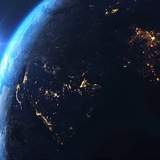This media is not supported in your browser
VIEW IN TELEGRAM
The star swallowed its planet - literally.
A lone giant the size of Jupiter could not escape from the gravitational trap and gradually spiraled into the red-hot bowels of its luminary. A colossal release of gas and dust into space, which astronomers have recorded under the name ZTF SLRN-2020.
It looks like a fantasy, but in the distant future — in five billion years — this could happen to our Solar system. When the Sun starts to die, it will swell up too, and anything that gets too close risks becoming a cosmic breakfast.
A lone giant the size of Jupiter could not escape from the gravitational trap and gradually spiraled into the red-hot bowels of its luminary. A colossal release of gas and dust into space, which astronomers have recorded under the name ZTF SLRN-2020.
It looks like a fantasy, but in the distant future — in five billion years — this could happen to our Solar system. When the Sun starts to die, it will swell up too, and anything that gets too close risks becoming a cosmic breakfast.
👍4🔥4🤣1🆒1
To make this shot, the astrophotographer needed not just a camera and a tripod, but 7 YEARS of STUBBORNNESS and a little luck.
He wasn't hunting for the moon, but for the perfect moment where everything would come together: phase, angle, weather, horizon. And every time — clouds, disruption, bummer.
But on December 15, at 18:57 Italian time, all the factors converged
He wasn't hunting for the moon, but for the perfect moment where everything would come together: phase, angle, weather, horizon. And every time — clouds, disruption, bummer.
But on December 15, at 18:57 Italian time, all the factors converged
❤17❤🔥3👍2🤩2
The moment when your view from the window is the whole planet…
The views from the ISS are such that filters are NOT NEEDED: the radiance of the atmosphere, the Milky Way, thousands of stars and the native Earth below.
All of this is footage from low Earth orbit, where day turns to night 16 times a day.
The footage was captured on camera by NASA astronaut Donald Pettit.
The views from the ISS are such that filters are NOT NEEDED: the radiance of the atmosphere, the Milky Way, thousands of stars and the native Earth below.
All of this is footage from low Earth orbit, where day turns to night 16 times a day.
The footage was captured on camera by NASA astronaut Donald Pettit.
❤8🤣3🤩2🆒2
❤️❤️ From orbit with love: Happy Europe Day!
Every year in May, residents of European countries celebrate Europe Day. In honor of this day, ESA has shared an exciting selection of photos from orbit.
Every year in May, residents of European countries celebrate Europe Day. In honor of this day, ESA has shared an exciting selection of photos from orbit.
👍5❤3🤣2🆒2
This media is not supported in your browser
VIEW IN TELEGRAM
The dynamics of vortices in the upper cloud cover of Jupiter, compiled from images obtained by the automatic interplanetary station "Juno"
❤6🤩4🍌2
This media is not supported in your browser
VIEW IN TELEGRAM
The huge size of space objects
❤🔥3🔥3🍌2👏1💋1🆒1
This media is not supported in your browser
VIEW IN TELEGRAM
Capture the Starship Super Heavy B15 booster during the IFT-8 mission. Shot in slow motion
👏5❤2
Welcome to the surface of our star!
In front of you is the photosphere of the Sun with a detail of up to 30 km.
In front of you is the photosphere of the Sun with a detail of up to 30 km.
👍3🔥3🍌2
This media is not supported in your browser
VIEW IN TELEGRAM
Here are the aurora borealis on Jupiter. Taken using the ultraviolet vision of the Hubble telescope.
👍4🍌2
Do you see a bright object with a tail? It's not a comet. This is MERCURY!
Yes, yes, the smallest planet in the Solar system has its own tail. It consists of sodium, which the solar wind literally blows off the surface of Mercury. From a distance, it looks like a glowing trail — and it's quite easy to confuse it with a comet.
Even the most modest planets can surprise.
Yes, yes, the smallest planet in the Solar system has its own tail. It consists of sodium, which the solar wind literally blows off the surface of Mercury. From a distance, it looks like a glowing trail — and it's quite easy to confuse it with a comet.
Even the most modest planets can surprise.
👍7❤🔥1
